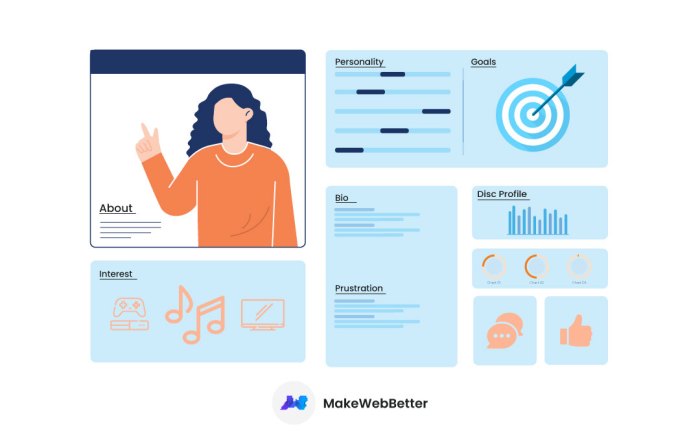Creating a Marketing Persona sets the stage for understanding your audience on a deeper level, paving the way for tailored marketing strategies that hit the mark. Dive into this guide for a fresh perspective on reaching your target market.
Marketing personas are essential tools in the modern business landscape, offering valuable insights into consumer behavior and preferences. By creating detailed profiles of your target audience, you can craft more personalized marketing campaigns that resonate with potential customers.
Understanding Marketing Personas
Marketing personas are fictional representations of your ideal customers based on real data and market research. They help businesses understand their target audience better and tailor their marketing strategies to meet the needs and preferences of specific customer segments.
Types of Information in Marketing Personas
- Demographic information: Age, gender, income, education level, etc.
- Psychographic information: Personality traits, values, interests, lifestyle choices.
- Behavioral information: Buying habits, online behavior, brand preferences.
- Goals and challenges: What motivates the customer, what problems they need solving.
Benefits of Detailed Marketing Personas
- Targeted marketing: By understanding your audience’s needs and preferences, you can create personalized marketing campaigns that resonate with them.
- Product development: Knowing your customers’ pain points and goals can help you develop products or services that address their specific needs.
- Improved customer engagement: Tailoring your messaging to different personas can lead to higher engagement and conversion rates.
- Optimized marketing channels: Identifying where your target audience spends their time online allows you to focus your marketing efforts on the most effective channels.
Researching Target Audience
When creating a marketing persona, it is crucial to conduct thorough research on the target audience to ensure the effectiveness of the marketing strategy. By understanding the demographics, psychographics, and behaviors of the audience, businesses can tailor their messaging and offerings to better resonate with their potential customers.
Research Process for Creating a Marketing Persona
To create an accurate marketing persona, businesses need to follow a structured research process. This involves conducting surveys, interviews, and analyzing existing data to gather insights into the target audience’s preferences, needs, and behaviors.
- Surveying: Sending out surveys to collect quantitative data about the audience’s demographics, preferences, and buying habits.
- Interviews: Conducting in-depth interviews with a sample of the target audience to gather qualitative insights and personal stories.
- Data Analysis: Analyzing existing customer data, website analytics, and social media insights to identify trends and patterns.
Methods for Collecting Data
When researching the target audience, businesses can employ various methods to collect data effectively.
- Online Surveys: Creating online surveys to gather quantitative data on demographics, preferences, and behaviors.
- Focus Groups: Organizing focus groups to delve deeper into the motivations and attitudes of the target audience.
- Social Media Listening: Monitoring social media platforms to understand what the audience is saying about the brand and its competitors.
Significance of Demographic, Psychographic, and Behavioral Information
Demographic information such as age, gender, income, and location provides a basic understanding of the target audience. Psychographic information delves deeper into their values, interests, and lifestyle choices. Behavioral information, on the other hand, Artikels their purchasing habits, brand interactions, and decision-making processes.
By combining demographic, psychographic, and behavioral information, businesses can create a comprehensive marketing persona that accurately represents their target audience.
Creating Customer Profiles

In order to create effective customer profiles, you need to analyze the information gathered from your research on the target audience. This data will help you understand the various segments within your audience and tailor your marketing strategies accordingly.
Segmenting the Target Audience
To segment your target audience into distinct customer profiles, you can start by identifying common characteristics among different groups of customers. This can include demographics such as age, gender, location, income level, as well as psychographics like interests, values, and behaviors. By categorizing your audience into specific segments, you can create more personalized marketing campaigns that resonate with each group.
- Use data analytics tools to identify patterns and trends in customer behavior.
- Survey your existing customers to gather more insights on their preferences and needs.
- Consider factors such as purchasing behavior, communication channels, and brand loyalty.
- Create buyer personas that represent each customer profile, including details like their goals, challenges, and decision-making process.
Influencing Marketing Strategies
Customer profiles can greatly influence your marketing strategies by helping you understand the unique needs and preferences of each segment. By tailoring your messaging and content to specific customer profiles, you can create more targeted and effective campaigns that drive engagement and conversion.
For example, if you have identified a customer segment that values sustainability, you can incorporate messaging around eco-friendly practices and products in your marketing materials to appeal to this group.
- Personalize your marketing efforts to each customer profile to increase relevance and engagement.
- Adapt your product offerings and promotions based on the preferences of different customer segments.
- Utilize customer feedback and data to continuously refine and optimize your marketing strategies for each profile.
- Monitor the performance of your campaigns for each customer profile and make adjustments as needed to maximize results.
Implementing Marketing Personas: Creating A Marketing Persona

Implementing marketing personas is crucial in tailoring content and messaging to specific target audiences. By creating detailed customer profiles, businesses can better understand the needs, preferences, and behaviors of their ideal customers, allowing them to craft personalized and relevant marketing strategies.
Tailoring Content and Messaging
Marketing personas help businesses create content that resonates with their target audience. By knowing the demographics, interests, and pain points of their customers, companies can develop messaging that speaks directly to their needs. This personalized approach increases engagement and builds stronger relationships with customers.
- Use language and tone that resonates with the persona.
- Create content that addresses the persona’s challenges and offers solutions.
- Utilize channels preferred by the persona for effective communication.
- Develop tailored offers and promotions based on persona preferences.
Product Development and Branding
Marketing personas play a significant role in product development and branding by guiding decisions on features, design, and messaging. Understanding the needs and preferences of different customer segments helps businesses create products that meet specific requirements and resonate with their target audience, ultimately leading to increased sales and brand loyalty.
- Use personas to identify product features that appeal to specific segments.
- Create branding elements that align with the values and preferences of the persona.
- Ensure product messaging is consistent with the persona’s language and interests.
- Gather feedback from personas to improve products and enhance brand perception.
Aligning Marketing Strategies
To align marketing strategies with created marketing personas, businesses must ensure that their campaigns, messaging, and tactics are tailored to the needs and preferences of their target audience. By consistently referencing and updating personas, companies can optimize their marketing efforts and achieve better results.
- Segment marketing campaigns based on persona characteristics.
- Create personalized content for each persona to increase engagement.
- Monitor and analyze persona interactions to refine marketing strategies.
- Continuously update personas based on new data and insights to stay relevant.
